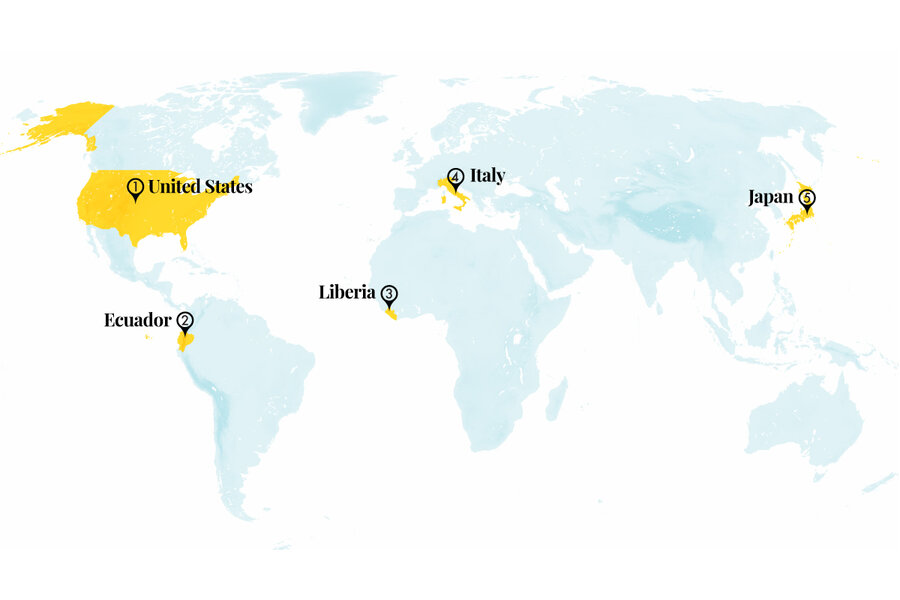When going to court – or the movies – leads to change
Loading...
1. United States
To address inequalities, states are reconsidering court fines and fees for juveniles. In a wide range of practices, courts impose fines as punishment and also charge fees for expenses such as court-appointed attorneys. Penalties are frequently levied regardless of an individual’s ability to pay, and they disproportionately affect Black and Hispanic youth.
But 21 states since 2017 have reduced or abolished the practice, according to the nonprofit Debt Free Justice. Six states – Arizona, Illinois, Indiana, Montana, Texas, and Washington – enacted reforms last year.
Why We Wrote This
A story focused onIn our progress roundup, the tragedy of one femicide coincided with the popularity of an Italian film about domestic violence, leading quickly to new laws. And in Ecuador, a court ruling in favor of one Indigenous group could lead to more land rights for others.
Studies have found that while monetary sanctions do not improve public safety, legal debt can increase recidivism rates among juveniles and strains those already struggling to afford basic needs. Last May, Arizona passed a law abolishing fees alone, while Montana, Washington, and Illinois have eliminated both fines and fees. Indiana, which never allowed fines in juvenile courts, now requires courts to prove that fees will not pose a burden for a defendant’s family. Texas became the first Southern state to abolish all juvenile court fees without condition.
In April, the U.S. Department of Justice released a letter to courts cautioning that some fines and fees may be unlawful and a violation of civil rights, and may trap youths and adults in a cycle of debt and incarceration. Also in 2023 Massachusetts, Michigan, and Pennsylvania introduced legislation to eliminate juvenile fines and fees.
Sources: The Conversation, Debt Free Justice, The New York Times, WFYI
2. Ecuador
Ecuador returned a piece of the Amazon to the Siekopai people in a landmark court ruling late last year. Pë’këya was the spiritual heart of Siekopai territory until the Ecuadorian-Peruvian war displaced the group in 1941. Though the country enshrined Indigenous land rights in its 2008 constitution, the government did not allow Indigenous ownership of territory within its National System of Protected Areas until 2017. The November 2023 ruling marks the first time Ecuador has granted Indigenous ownership of conservation land, which may serve as a precedent for other Indigenous claims.
Evidence used in court included 18th-century Jesuit documents held at the New York Public Library, and testimony by representatives of the United Nations High Commissioner for Human Rights plus other Indigenous groups. The recovered 42,360 hectares (164 square miles) of land contains many places sacred to the group, including the rivers Emuña and Kwiñajaira. The court also ordered that the Ministry of Environment, Water and Ecological Transition publicly apologize to the Siekopai people.
The Siekopai view their homeland as an intrinsic part of their identity. “Many believe that we want to return for the sake of beauty, but that’s not the case,” said Maruja Piaguaje, a group leader. “It’s not a problem of land – it’s a matter of the spirit, of not suffering anymore.”
Sources: El País, Amazon Frontlines, Future Crunch
3. Liberia
Envisioned by a former child soldier, a program of therapy and cash grants is giving others a second chance in Liberia. Fourteen years of civil war, starting in 1989, precipitated a surge in drug use, poverty, and violent crime – particularly among young men, many of whom were recruited as soldiers during childhood. After finding help for his own trauma through a church program, in 2004 Johnson Borh founded the Network for Empowerment & Progressive Initiative (NEPI) to reintegrate marginalized men into their communities.
In an eight-week program, NEPI uses cognitive behavioral therapy to teach strategies for regulating emotions. Participants learn “how to interact in shops and banks and how to manage money,” said Mr. Borh. “These things may sound strange, but men who spent their youth as child soldiers can struggle to do these basic things without resorting to anger.” Upon completion, $200 grants can be used for school or to start a business.
In 2015, U.S. researchers demonstrated the effectiveness of cash transfers after therapy in the NEPI program. The results inspired READI, an initiative in Chicago to reduce gun violence, which combines a 12-to-18-month job with cognitive behavioral supports. A study from the University of Chicago Crime Lab in 2023 said that the approach holds promise, and continued monitoring makes it the “largest and most rigorous evaluation of a community-based violence intervention program” in the United States.
Sources: Positive News, University of Chicago Crime Lab
4. Italy
A film about domestic violence has become one of Italy’s highest-grossing movies, focusing the nation on women and their power in society. “C’è ancora domani” (“There’s Still Tomorrow”) follows a woman in post-World War II Rome as she tries to vote on a referendum against her abusive husband’s wishes. The film, a directorial debut by comedian Paola Cortellesi, is one force credited with inspiring mass protests against the November 2023 killing of a student, allegedly by her ex-boyfriend. Elena Cecchettin, the victim’s sister, has shared her grief by being vocal in the media about patriarchal values.
Shortly after Giulia Cecchettin’s death, the Senate passed a law to strengthen protections for women, and the education minister dedicated €15 million ($16.5 million) for relationship education in schools. Italy’s rate of femicide is the fifth lowest in the European Union. But women say chauvinist attitudes are long entrenched, and point to the gap between laws and their application.
On Nov. 25, the United Nations’ International Day for the Elimination of Violence Against Women, hundreds of thousands of protesters took to the streets. Members of the Italian Senate watched the film to mark the day. Just that week, more than 55,000 teenagers throughout the country also saw the film and participated in a question-and-answer session with the director and some cast members. The film has “touched a raw nerve in the country,” said Ms. Cortellesi.
Sources: The Economist, The New York Times
5. Japan
To save an endangered butterfly, conservationists and a farming town are working to find the balance between overuse and underuse of the environment. As a species that evolved to thrive amid human activity, the Reverdin’s blue butterfly declined as people left the countryside. But in Iijima, a small community in Nagano prefecture, carefully monitored satoyama landscapes are helping nurture a species that is recognized as a local treasure.
Satoyama are mosaic landscapes where habitats such as rice paddies, grasslands, and farms exist together. In Iijima, researchers from the University of Tokyo created butterfly sanctuaries in four abandoned grasslands adjacent to rice paddies. Modest landscape use is crucial to success, as too much or too little maintenance increases the butterflies’ vulnerability to parasites. Community involvement is another piece of the puzzle, and the town disseminates regular updates about the project. So far, scientists have released 1,200 pupae at seven sites. At five locations, the butterflies remain after four generations.
The Iijima work is aligned with the International Partnership for the Satoyama Initiative, which promotes human activity that is in harmony with nature. Other integrated landscape projects include dehesa woodlands in Spain and Portugal and ahupuaa mountain habitats in Hawaii.
Source: Mongabay











